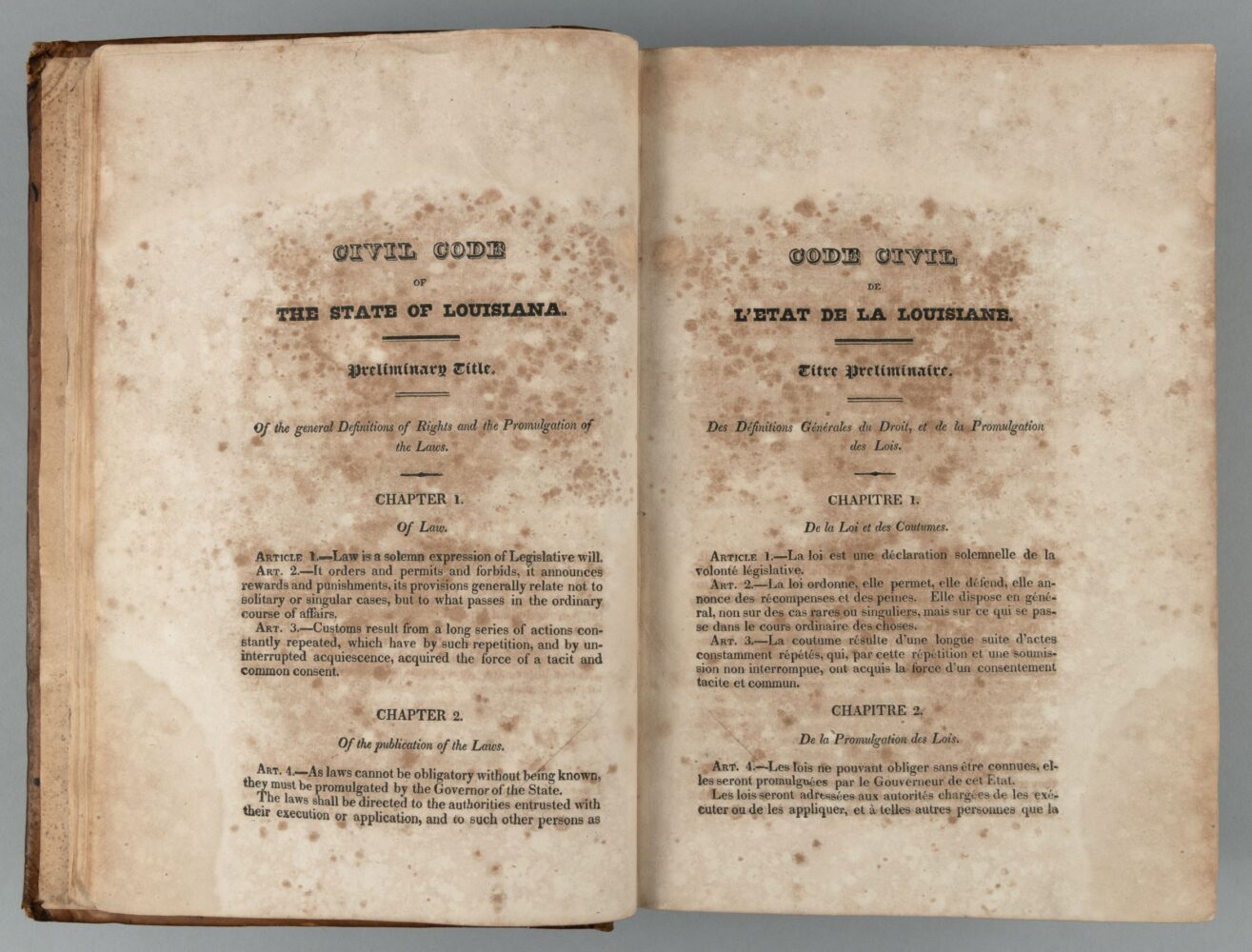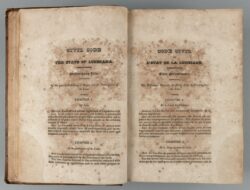Napoleonic Code
The French Civil Code of 1804 standardized civil law in France, becoming a model legal framework for jurisdictions around the world, including Louisiana.
This entry is High School Civics level View Full Entry

The Historic New Orleans Collection
An interior spread from the Civil Code of the State of Louisiana, featuring an English translation on one page and French on the opposite page.
What is the Napoleonic Code, and how was it developed?
The Napoleonic Code (Code Napoléon), or French Civil Code of 1804, is the foundation of French private law today. The code is influenced by Enlightenment ideas and the revolutionary spirit that gripped France at the time of its creation. The code covers a range of legal interactions between private citizens, including property transactions, contracts, sales, leases, and wills.
There was a lot of variation in French law before the Napoleonic Code. Southern France was known as the region of written law because of the influence of written Roman law there. Northern France, including Paris, was known as the region of customary law due to the influence of Frankish and Germanic customary law, much of which wasn’t written down. In fact, laws in France prior to the French Revolution (1789–1799) were so inconsistent that the French intellectual and literary figure Voltaire reputedly quipped that one changed laws as often as one-changed horses when riding through the country.
After the French Revolution a politically unified country required a unified law. Although it wasn’t the first civil code to be passed, it was the most influential one. Napoleon’s political savvy and strong will helped pass the civil code, and his influence is evident in areas like divorce and adoption. The work of drafting a civil code, however, was largely accomplished by a commission. In 1800 Napoleon appointed a group of four experienced legal practitioners: François Tronchet (president of France’s supreme court for private law matters), Félix Bigot de Préameneu (a lawyer in the French government), Jacques de Malleville (a judge), and Jean Portalis (an administrative official). In only four months the commission produced a draft of the civil code.
What is included in the Napoleonic Code?
The French Civil Code includes 2,281 articles and is made up of three separate sections or “books.” Book I outlines the rights of people. Book II addresses property. Book III deals with the rights that people have in things, including rights acquired by contracts, sales, successions (inheritances), and other manners.
Book I regulates institutions such as marriage, guardianship, and tutorship, as well as the family, which was thought of as the basic unit of civilized society. Although the revolution generally recognized women as equal to men, the father remained the head of the family. The code recognized divorce, but it wasn’t easily allowed. Adultery and cruel treatment were legitimate reasons for divorce, but the more lenient rules that were common during revolutionary times, including divorce by mutual consent, were rejected.
Book II adopts revolutionary principles for property law. Its key principle was that everyone had the same rights to property no matter whether people were rich or poor or if they came from the upper or lower classes.
Book III, which is a collection of various types of legal transactions, stayed true to tradition while making some important changes regarding torts and special contracts. (A tort is a civil wrong committed against someone that requires the person who committed the wrong to pay compensation to the injured party. A modern-day example is a car accident, where the person at fault is responsible for paying for the damage. An example of a special contract is a lease.) Book III covers successions, donations, and wills. The drafters also changed how successions, donations, and wills were handled by rejecting old ideas about firstborn children and male heirs. In Book III the drafters balanced the idea of individual freedom with family unity and the obligation to leave property to heirs after death.
The French Civil Code was comprehensive, rational, and logical, but it didn’t specify every rule governing human interactions. Rather, the drafters were careful not to over-legislate every aspect of life. Instead, any gaps in the code would be filled by logical and rational reasoning and comparison to other provisions of the code.
There have been some revisions to the French Civil Code over the last two hundred years, but none have been extensive. As a result, the code retains its essential, Napoleonic character. Between the 1960s and 1980s, partial changes were made to laws relating to family, spouses, and successions. More changes were made after 2000 to the law of successions and, most recently, the law of contracts. Gaps have inevitably been discovered and filled with supplemental codes and legislation on specialized topics, as well as with judicial decisions and academic commentary.
How did the Napoleonic Code influence the laws of other places, including Louisiana?
The French Civil Code was adopted in many European countries, either by exporting it to colonies or by imposing it through conquest in places like Belgium, Luxembourg, Holland, Italy, and some Germanic territories. As jurisdictions codified their own laws in the early twentieth century, the French Civil Code spread even further. These jurisdictions include European countries such as Italy, the Netherlands, Spain, and Portugal, as well as Romania and other jurisdictions on the Balkan Peninsula. In Latin America the French Civil Code was copied or imitated in Chile, Ecuador, Bolivia, Puerto Rico, and Uruguay. Egypt and Lebanon also followed the lead of the French Civil Code.
The influence of the French Civil Code extended to North America and was important to the formation of laws in Québec and in Louisiana, the latter being the only US jurisdiction with a civil law system. The connection of Louisiana civil law to French civil law is natural. Louisiana was a French colony first from 1699 to 1762 and then again from 1800 to 1803. In addition, Louisiana’s first written drafting of its laws occurred in 1808, a mere four years after the enactment of the Napoleonic Code. There’s still debate over whether the Louisiana Digest was based on Spanish or French law, but there’s no doubt that French sources heavily influenced Louisiana’s Civil Code when it was revised in 1825. In the 1950s, English translations of French scholarship on the French Civil Code were prepared and disseminated in Louisiana, which became influential and instructive material for interpreting the Louisiana Civil Code. Even today Louisiana courts continue to consult the French Civil Code and related sources when determining the meaning of various provisions in the Louisiana Civil Code. For example, when the courts find that a provision of the Louisiana Civil Code is unclear, judges and lawyers consult the French Civil Code because it’s the source of Louisiana law. Consultation of the French Civil Code applies only in Louisiana, as it’s the only state in the country whose laws are based on French, rather than English, law. Outside of Louisiana, states rely on English common law, which is based on legal precedents established by the court system.
